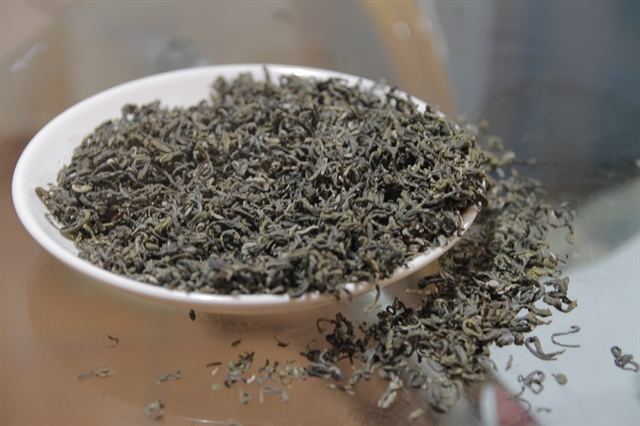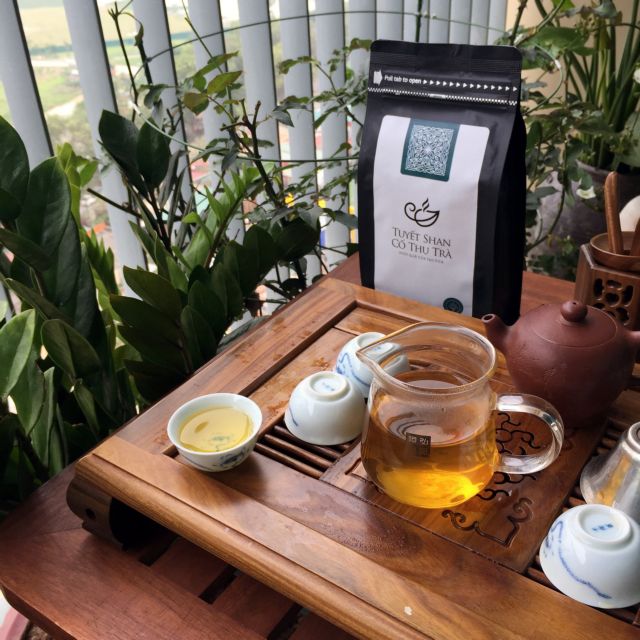 Life & Style
Life & Style

Shan tuyết tea in Yên Bái Province’s Suối Giàng Commune is well known across Việt Nam for its pleasant flavour and fragrance.

|
| Shan tuyết old tea trees in Suối Giàng District of Yên Bái Province. Photo baoyenbai.com |
By Hoàng Hồ
Shan tuyết tea in Yên Bái Province’s Suối Giàng Commune is well known across Việt Nam for its pleasant flavour and fragrance.
The tea trees grow wild on the majestic Hoàng Liên Sơn Mountain about 1,500m above sea level.
Elder Giàng A Lử of the commune’s Giàng B Hamlet recalled that a long time ago when Mông ethnic people led a nomadic lifestyle, they often faced poverty and hunger.
They were constantly on the move looking for somewhere to settle, and eventually found a fertile land with lush forests and streams at the foot of a mountain, Lử said.
He said the group were happy but continued to face difficulties. Their children were fed on mèn mén (steamed maize powder) and green leaves from the forest.

|
| Hand-made shan tuyết tea is so excellent tasty that tea addicts have to order several months in advance. Photo Hồ Hoàng |
After watching the local animals eating the green buds, the group grew curious and decided to cook it up for themselves, and immediately felt refreshed and healthy.
“The leaves are wonderful,” he said, adding they had been named shan tuyết and the land Suối Giàng (Heavenly Stream).
“It has spirit of the heaven and Earth so it is excellent in quality. Local people consider the old tea trees a treasure from heaven, and thanks to them many families have become rich,” Lử said.
He recalled another story: In the 70s, K. Djenmukhaze from Russia visited Suối Giàng and said the tea was equal to that of Japan such as Roast Sencha Tea, China’s Tie Guan Yin and Sri Lanka’s Royal Ceylon.

|
| Several Mông households still prepare tea by hand to preserve their old tradition. Photo baoyenbai.vn |
A shan tuyết tea addict from Hà Nội, Nguyễn Ngọc Thọ, said he often travels to Suối Giàng to buy and enjoy the tea from his elder brother Tạ Ngọc Thăng's plantation.
“Although the tea is available at shops in the capital, I still like my brother’s process of picking the tea buds from the trees and drying them in a pan by hand.”
In modern times, tea makers often dehydrate the leaves by machine, but my brother is trying to keep the old tradition because it makes the tea more fragrant.
“ We wake up very early in the morning to travel and climb Suối Giàng Mountain about 12km from my brother’s home to pick the buds because after 10am the tea is not tasty.

|
| A Mông ethnic girl in Suối Giàng picks shan tuyết tea buds in early morning. Photo Enternews.vn |
“Thăng told us that the most suitable time to pick the tea buds is on cool or foggy days and we should dehydrate them as soon as possible to keep the original flavour,” said Thọ.
The next step is to crumple them very carefully to ensure quality, Thăng said, noting the most difficult part was dehydrating them over a fire while adjusting the temperature and stirring them by hand for almost an hour until they became white and crispy.
“I make the white tea on the spot in a ceramic pot and when I take a cup of tea and sip it, its fragrance and excellent are beyond compare.
Thăng said although his tea cannot meet the increasing demand, he prefers to stick to the traditional methods left by his ancestors rather than using a machine to please his regular customers from Hà Nội, HCM City, South Korea and Thailand.

|
| Shan tuyết tea buds should be brewed in a ceramic pot to make them tasty and fragrant. Photo shantuyetcothutra.vn |
Apart from tea buds, shan tuyết fresh green tea leave is also very tasty, said Thắng. The leaves have to stew for 30 minutes rather than 10 minutes for tea in the lowlands because it enhances the flavour.
An official from Văn Chấn District, Nông Ích Chấn, said his locality had 540ha of old shan tuyết tea trees, and 400 had been recognised as Việt Nam Heritages Tree because they were more than 300 years old.
However, Chấn said the trees and the livelihoods of 300 households were at risk from termites, and called on authorities to work to maintain the valuable quality of shan tuyết tea. — VNS